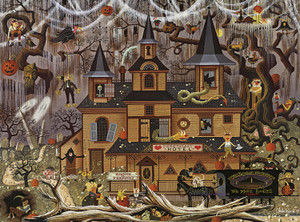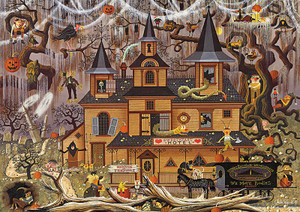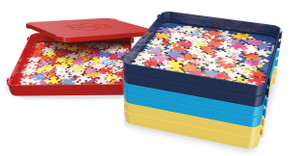Posted by Buffalo Games on Aug 17th 2022
What Parts of the Brain Do Jigsaw Puzzles Stimulate?
Let’s face it; there’s a lot going on in the average everyday life these days. Technology is so pervasive that it has arguably become invasive.
We are constantly bombarded with sounds, images, bursts of light, sensations, and other stimuli. We’re hammered by incessant and repetitive ads that aren’t necessarily designed to convince but to overwhelm through recurrence. All this noise can seriously mess with your head.
Although we don’t pretend to be engaged in a medical study, nor are we giving medical advice, there really is such a thing as TMI (too much information).
Your brain can be overwhelmed to the point that it disconnects from your surroundings. It does this so that it can better process inputs. This is called ambient neural activity, but you might know it as daydreaming or “zoning out.” It happens because your brain is overwhelmed with the data it has to process in a given environment.
There’s a lot about the standard modern life that’s not ideal, but jigsaw puzzles can be a step in the right direction for many people, no matter your age or ability.
How Jigsaw Puzzles Help Your Brain
First, you have to know that there is a definite connection between the activity of regularly solving jigsaw puzzles and positive change in your thought life. If you’ve ever had a pop song stuck in your head, you know what it’s like to need a mental reset. You just need something else to focus on because you’re starting to feel a little crazy.
Sitting down to solve a simple 100-piece puzzle can give your brain relief from the stressors of modern life. Puzzles have the following benefits:
- Memory is engaged in helping retain data on color, shape, etc.
- Cultivates synergy between analytical left brain and creative right brain
- Learning is catalyzed (important as we age)
- Reward through the body’s production and delivery of dopamine
The exercise of solving jigsaw puzzles engages the process of challenge and reward. The feedback loop of these micro activities is quite small. Each time you fit a piece to the puzzle, you get a little dopamine reward, reinforcing beneficial pathways in your brain.
On top of all this, you get the benefits that come from the meditative experience that’s cultivated through gazing at a single image for a length of time instead of millions of images flashing on a screen in harmful LED blue light.
What Parts of the Brain Benefit from Stimulation with Jigsaw Puzzles?
There are a lot of things modern medicine cannot explain, and this is especially true in regard to how the brain works (typically categorized as psychology).
In fact, psychology’s root word, “psyche,” originated in ancient Greek and means breath, life, or soul. Not to get mystical, but there’s a lot we don’t know about how humans think and why.
Researchers have surmised that there’s a lot going on in a substructure of the brain that rolls right off the tongue: the ventrolateral prefrontal cortex (VLPFC).
Your VLPFC and You
Located pretty much smack dab between your temples, the VLPFC acts like a brake against distractions. It uses a lot of glucose (the fuel burned by your brain) and can be temperamental.
It does function in a way that aids focus, which helps guard against distraction, but try not to think of a jigsaw puzzle right now. See how delicate the balance is?
When loud noises and bright lights break into your environment, the VLPFC is the mechanism in your frontal lobe that allows you to keep those distractions at bay. Like most things in this life, it works best when you use it often.
Types of Focus
The reason puzzles can benefit you so profoundly is that they’re like a life ring to a drowning person. The sea is the constant stimulus of a modern, digitally connected life. The puzzle is the point of focus the brain needs to be able to keep swimming.
The puzzle enables the primary function of the VLPFC, helping it to work against all that noise and get you into a state of mental focus or attention, of which there are three primary types.
Divided Attention
You use this mode of thinking when you’re doing complex activities that require multiple “lanes” of focus at the same time. For instance, driving a vehicle requires your cognitive awareness of things like road markings and signs, but it also requires fine motor coordination, balance, memory, situational awareness in regard to road hazards, and so on.
Jigsaw puzzles help train and maintain functionality for when you need to exercise divided attention because they require a constant “switching” between different “lanes” of thought – memory, sorting, problem-solving, creative thinking, and more.
Selective Attention
Pretty much the opposite of the above, this mode of thinking is akin to meditative thought or regular quiet times when you’re all alone, and there’s little to no input. In this mode, you are focused on a single thought or set of thoughts.
Not many people practice this kind of thinking these days. But you don’t have to join a cloister or cult to engage in the discipline of selective attention. Jigsaw puzzles help here, too. The constant, undivided attention you practice in gazing at the puzzle’s single image can actually be quite calming.
Sustained Attention
Basically a long-form version of selective attention, this benefit is realized when you’re working on a jigsaw puzzle for long periods of time. All three modes of attention benefit your overall mental acuity, especially as you age.
Give Your Brain a Hand
If any of these thoughts have found resonance with you, you owe it to yourself to make solving jigsaw puzzles a regular activity. They’re fun, they’re good for you, and they can be a great way to bring the family together for an evening of teamwork and conversation as you puzzle together.
Best of all, puzzling actually has brainy benefits! So give your brain a hand and stick a jigsaw puzzle in it (not literally).


















































